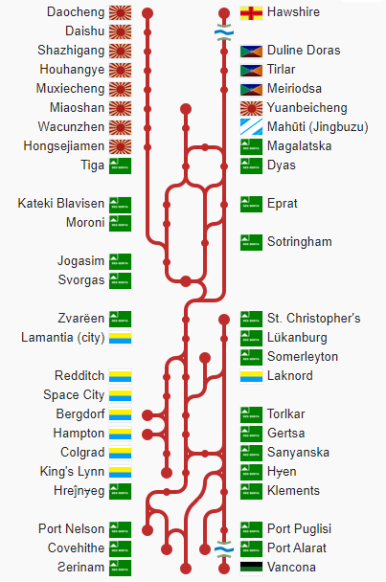Rail transport in Senya: Difference between revisions
No edit summary |
|||
| Line 11: | Line 11: | ||
The network runs entirely on [[wikipedia:Standard gauge|standard gauge]] (1,435 mm, 4 ft 8 1⁄2 in) rails, with the vast majority of lines having overhead electric wires. | The network runs entirely on [[wikipedia:Standard gauge|standard gauge]] (1,435 mm, 4 ft 8 1⁄2 in) rails, with the vast majority of lines having overhead electric wires. | ||
===Connections to foreign nations=== | |||
The Senyan network currently contains connections to both [[Arboria]] on the [[Dyas]]–[[Meiridosa]] line, and to [[Jingdao]] on both the [[Tiga]]–[[Mahūti]] and [[Jogasim]]–[[Hongsejiamen]] lines. Currently, intermediate border stations where trains stop where customs and immigration officials inspect goods and check passports. Services exist connecting Svorgas to Meiridosa and [[Tirlar]] in Arboria, with the Jingbuzu line supporting services to the Jingdaoese port city of [[Yuanbeicheng]] (Port Nevermore) and the Hongsejiamen line supporting long distance services to [[Daocheng]] via some coastal cities in southern Dalmacija. Most commercial services along these lines are run by Senyan Rail. | |||
==Train numbering system== | ==Train numbering system== | ||
Revision as of 12:01, 18 June 2020
Senya has an extensive railway network which serves the vast majority of settlements in the country. Unlike other nations, where automobiles are more popular, the Senyan government has for the most part invested heavily in the nation's rail network, ensuring that is the most reliable and convenient mode of transport.
The entire network is ran by Senyan Rail, who operate the vast majority of freight and passenger services across the country under various brand identities. The network is largely electrified and has connections to Jingdao and Natopia.
Fort Kolgrad and Ranentsi also have rail links. Fort Kolgrad's network is run by Senyan Rail and is extensive, linking all populated settlements with a relatively high speed network. Ranentsi's networks are older and weaker, and rely on older rolling stock. Ranentsi's network contains one line, running from Kyustendil to Kriva. Ranentsi's railway is run independently of Senyan Rail, though a takeover is planned.
Network
All rail infrastructure in Senya is owned by the state owned company Senyan Rail, who are responsible for the maintenance of the network. Senyan Rail additionally control all the various passenger and freight companies that operate on Senyan territory, with the exception for foreign companies from border countries running services into Senya.
The network runs entirely on standard gauge (1,435 mm, 4 ft 8 1⁄2 in) rails, with the vast majority of lines having overhead electric wires.
Connections to foreign nations
The Senyan network currently contains connections to both Arboria on the Dyas–Meiridosa line, and to Jingdao on both the Tiga–Mahūti and Jogasim–Hongsejiamen lines. Currently, intermediate border stations where trains stop where customs and immigration officials inspect goods and check passports. Services exist connecting Svorgas to Meiridosa and Tirlar in Arboria, with the Jingbuzu line supporting services to the Jingdaoese port city of Yuanbeicheng (Port Nevermore) and the Hongsejiamen line supporting long distance services to Daocheng via some coastal cities in southern Dalmacija. Most commercial services along these lines are run by Senyan Rail.
Train numbering system
All trains that operate within Senya are assigned a fifteen-character service code so as to identify the service. Trains are assigned a string of numbers, which feature on passenger's tickets as well as the main rail switchboards and on information and timetable displays at stations.
| Position | Displays | Code | Definition |
|---|---|---|---|
| 1 | Route type | 1 | International service |
| 2 | Inter city route | ||
| 3 | Regional service | ||
| 4 | Commuter route (including S-Rail) | ||
| 5 | Metro line | ||
| 6 | Tram line | ||
| 7 | Narrow gauge and heritage railways | ||
| 8 | All other rail types (including freight services) | ||
| 2-3 | Area of departure and arrival stations | 0 | Foreign country |
| 1 | Svorgas district | ||
| 2 | Jogasim district | ||
| 3 | Moroni district | ||
| 4 | Tiga district | ||
| 5 | Dyas district | ||
| 6 | Eprat district | ||
| 7 | Northern Senya | ||
| 8 | Lamantia | ||
| 9 | Tiana | ||
| 4-6 | Code of departure station | ||
| 7-9 | Code of arrival station | ||
| 10-13 | Scheduled departure time | ||
| 14 | Control type | A | Automated |
| M | Manual | ||
| 15 | Train type | F | Freight |
| P | Passenger | ||
Code displays
The way the code is displayed can vary depending on the situation and what information is required to be relayed. The full fifteen digit code is only used by the track operators, where as the thirteen digit code is used publicly by the rail providers to show their route. However, shorter codes are also regularly displayed.
The following table uses the example of a 3pm express train from Svorgas to Eprat to exemplify how a service may be displayed.
| Code | Digits | Use |
|---|---|---|
| 216-SVOEPR-1500-MP | 15 | Full service code, used by track operators |
| 216-SVOEPR-1500 | 13 | Passenger code, used by train operators and on passenger tickets |
| 216 15:00 EPRAT | 8+ | Station display code, used at stations, will often include intermediate stations |
